ecosystem-guides.com
....exploring the planet's ecosystems
AUSTRALASIAN
Temperate Dry Sclerophyll Forest & Woodlands
(south-eastern)
These 'bush' habitats include the classic vegetation communities most Australians are more familiar with, as they surround (and hopefully still infiltrate) the sprawling urban areas of our biggest cities in south-eastern Australia. There is an ecologically equivalent area of temperate Eucalypt forest and woodlands in south-western Australia with different species of plants and animals.
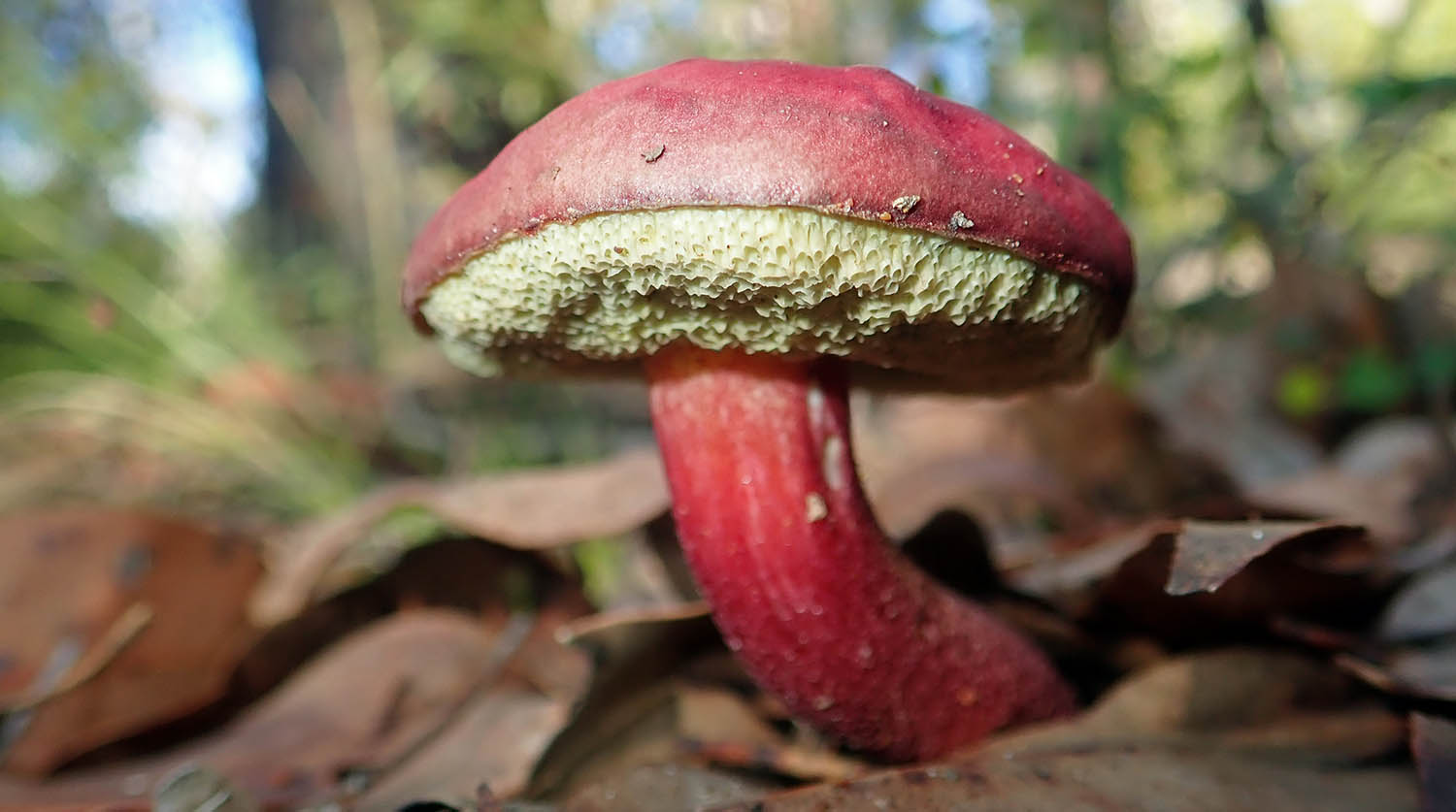 'Rhubarb Bolete'
'Rhubarb Bolete'The vegetation communities of Australia's southern woodlands are very diverse compared to many other temperate areas around the world. They are usually dominated by species of Eucalyptus. These ecosystems even have their own distinctive smell: due to the aromatic oil glands in the leaves of Eucalyptus trees, most Australian naturalists love the odour of the bush, even after a fire. Their distinctive smell when encountering planted specimens while travelling overseas instantly evokes memories of home.
The conifers of the order Pinales are normally thought of as a more northern hemsiphere group, and indeed they dominated communities there. However, there are interesting and endemic species in the southern Australian plant communities. The Cypress family Cupressaceae includes over 130 species of conifers, with many monotypic genera. Below is Callitris columellaris, 'White Cypress Pine', 'Murray River Cypress Pine'. Widespread in open habitats across Australia, (if the species includes Callitris intratropica). Round cones with dark lines separating segments.
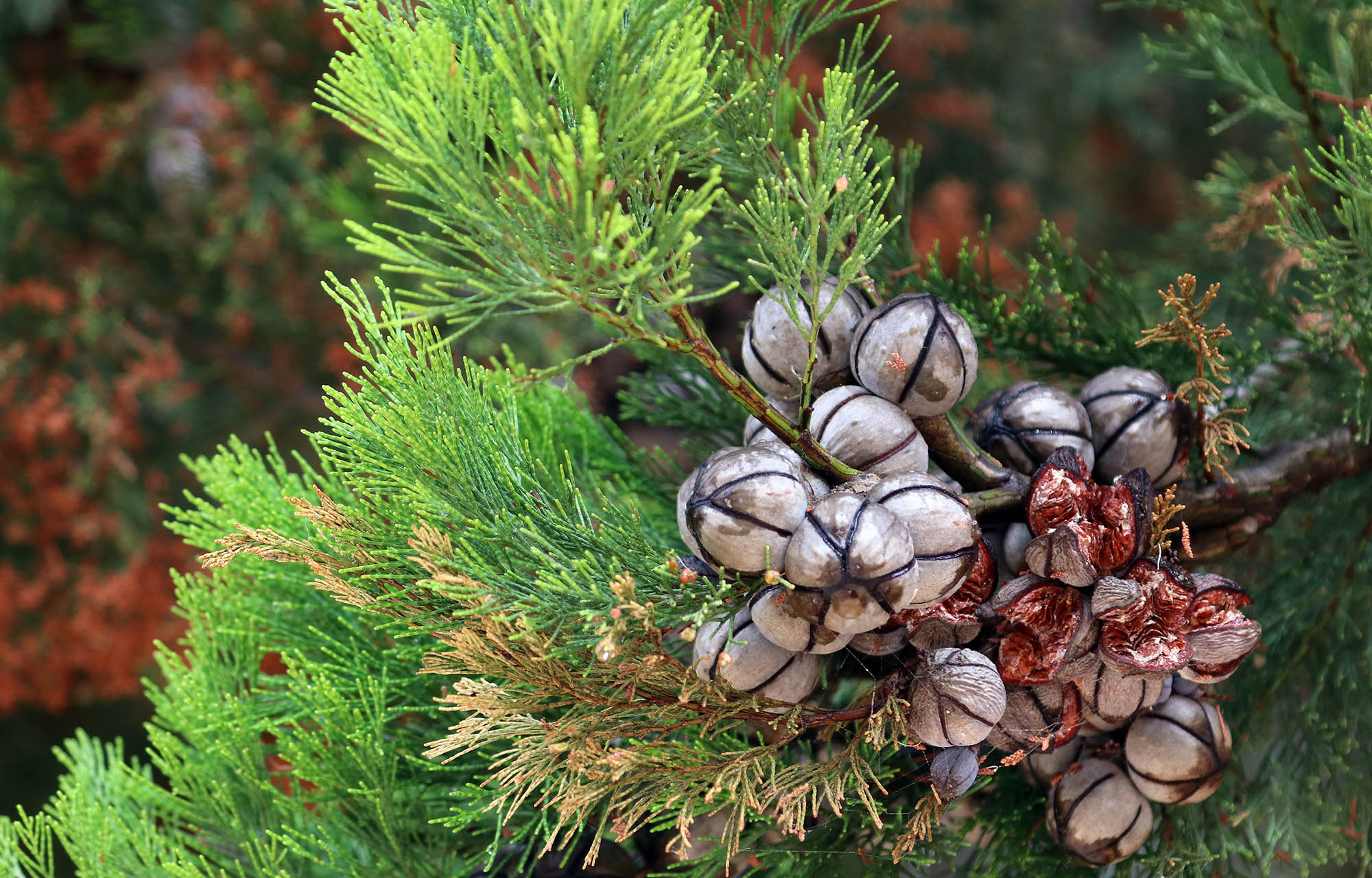 (Lashmar, Kangaroo Island)
(Lashmar, Kangaroo Island)The family Casuarinaceae is another important family the contains canopy trees in the temperate woodlands. The Allocasuarina genus (fruit below) is closely related to Casuarina, and all the species are endemic to Australia.
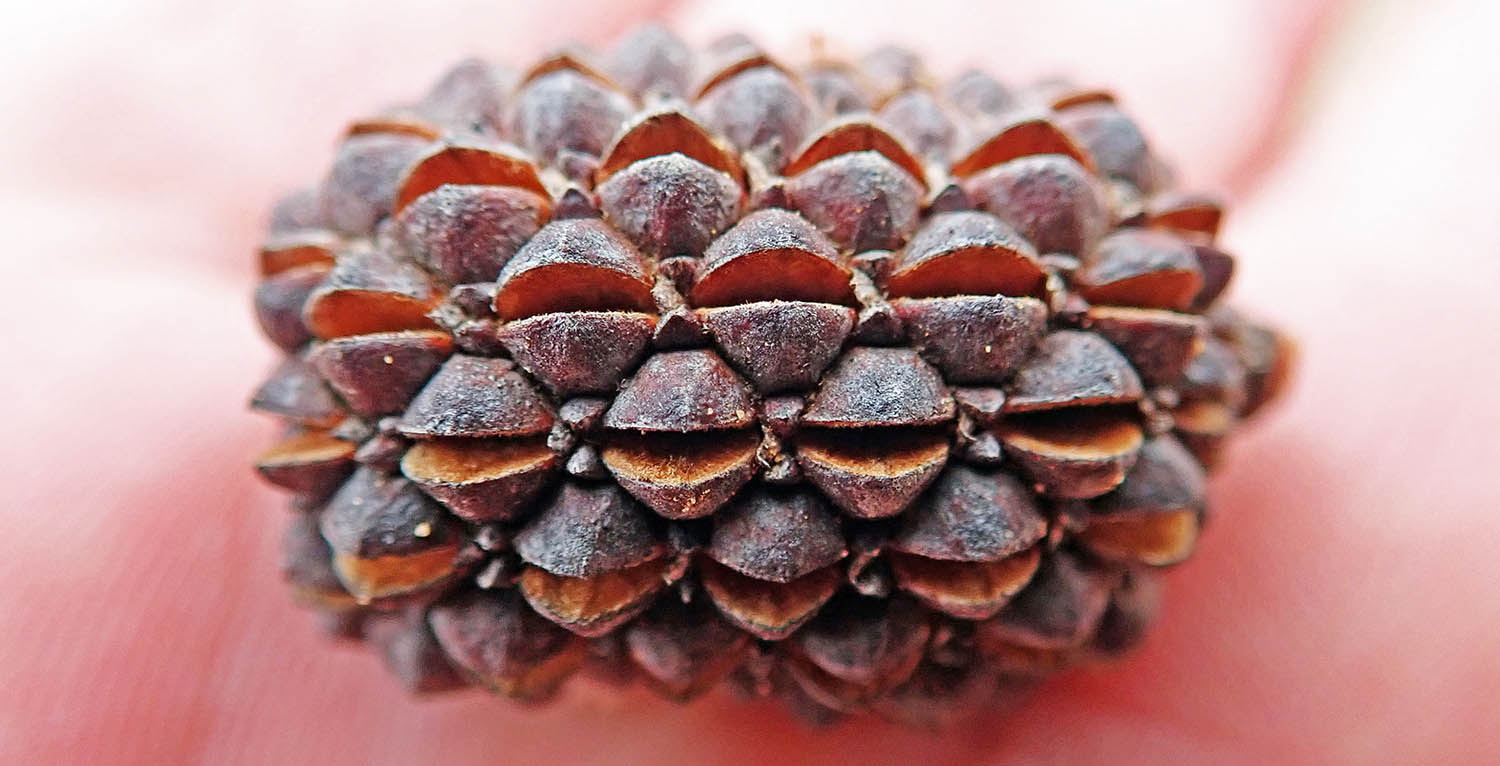
The family Mrytaceae dominates the south-eastern forests and woodlands. The main group are of course the Eucalypts, but there are many other genera that grow as both canopy and understory trees and shrubs. An example of this are 'Paperbark' Melaleuca.
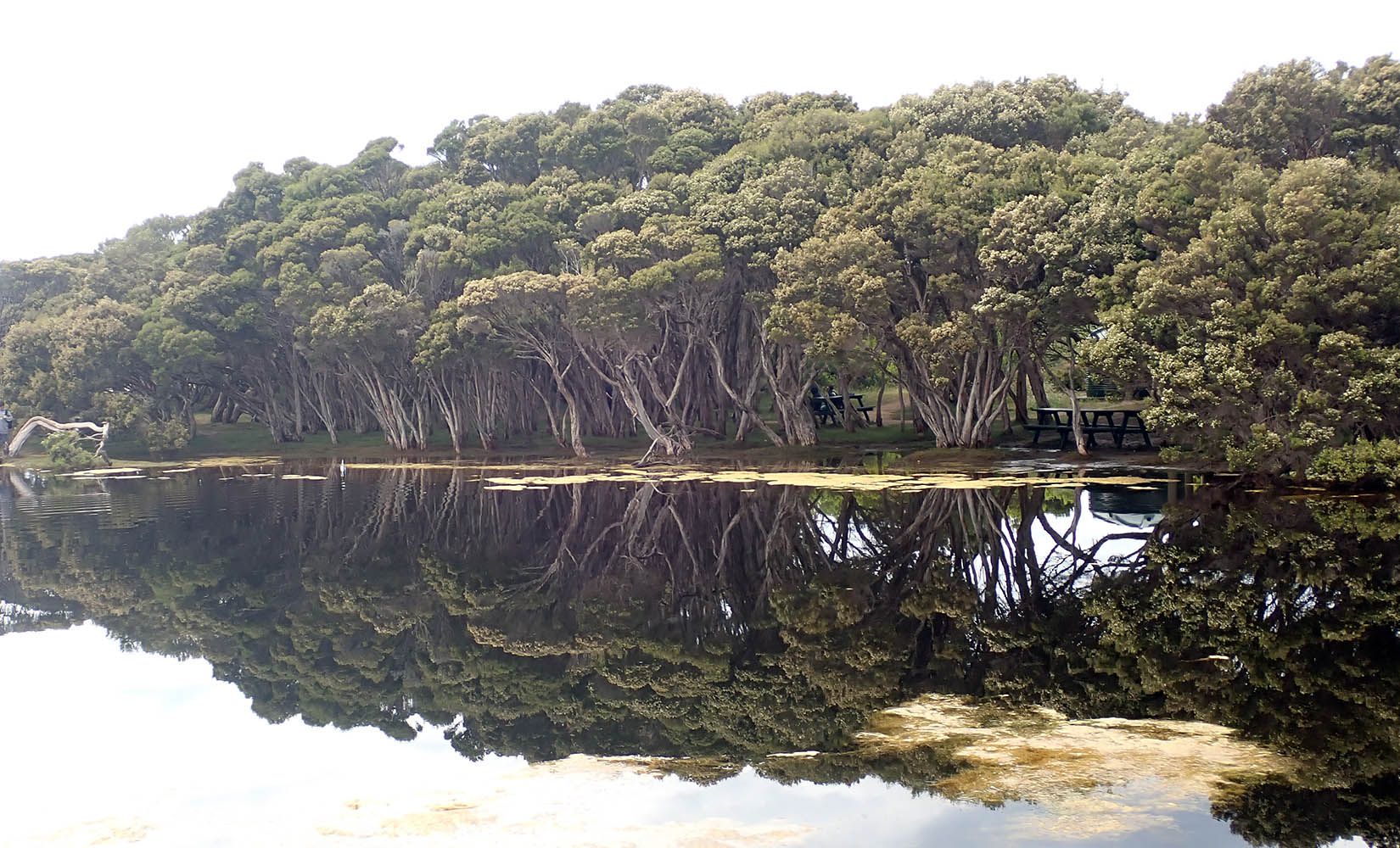
Below is Melaleuca halmaturorum, 'South Australia Swamp Paperbark', 'Salt Paperbark'., which can survive in more saline waters near coast. It is a small tree that often grows stunted and twisted. It has flakey bark and small white flowers at end of stems.
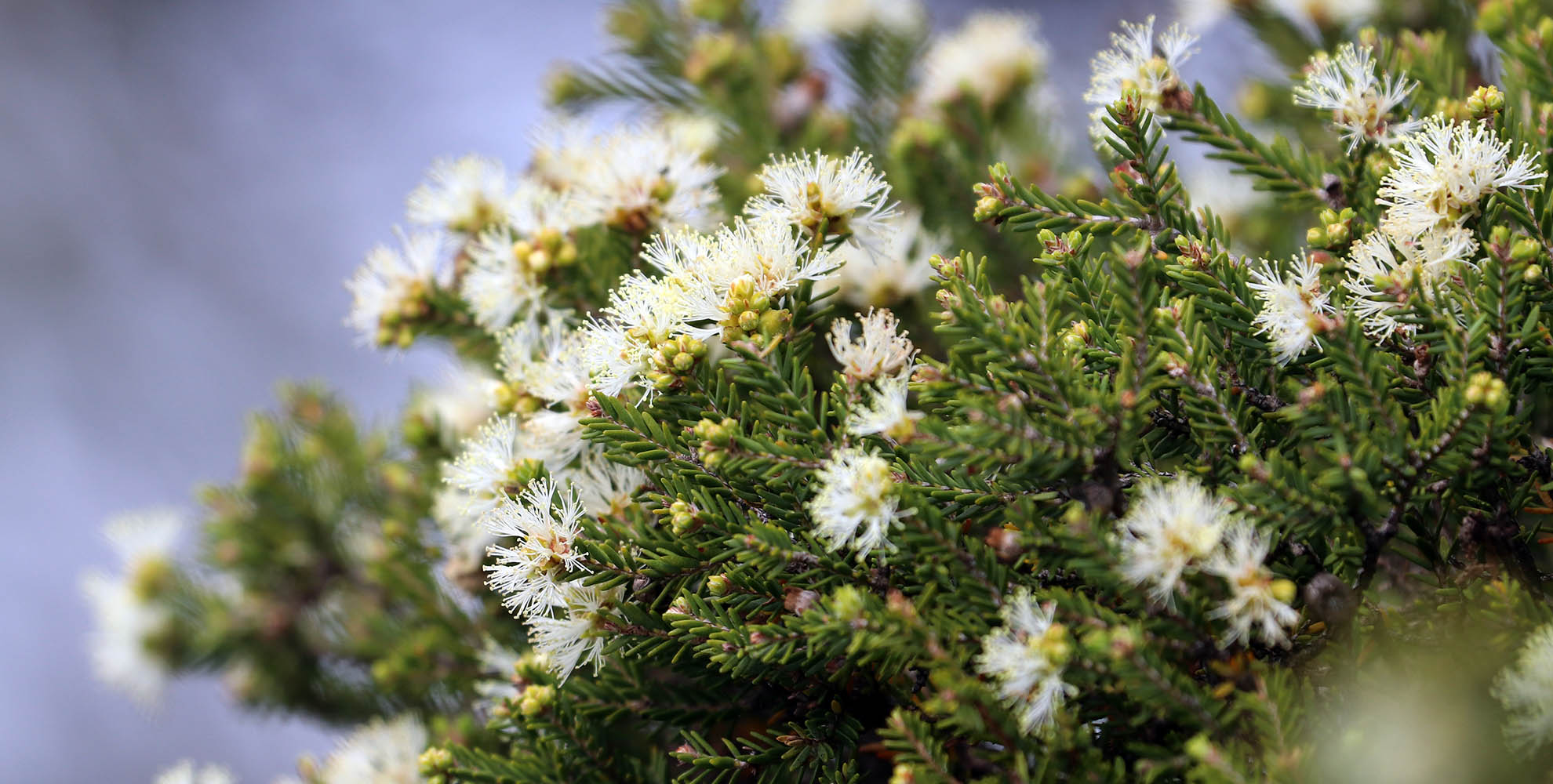 (Lashmar Conservation area, Kangaroo Island)
(Lashmar Conservation area, Kangaroo Island)Another group of trees that dominate vegetation communities in the temperate forest and woodlands are the Leptospermum species, often called 'Tea Trees'. Below is Leptospermum grandiflorum, which is endemic to the wetter parts of Tasmania.
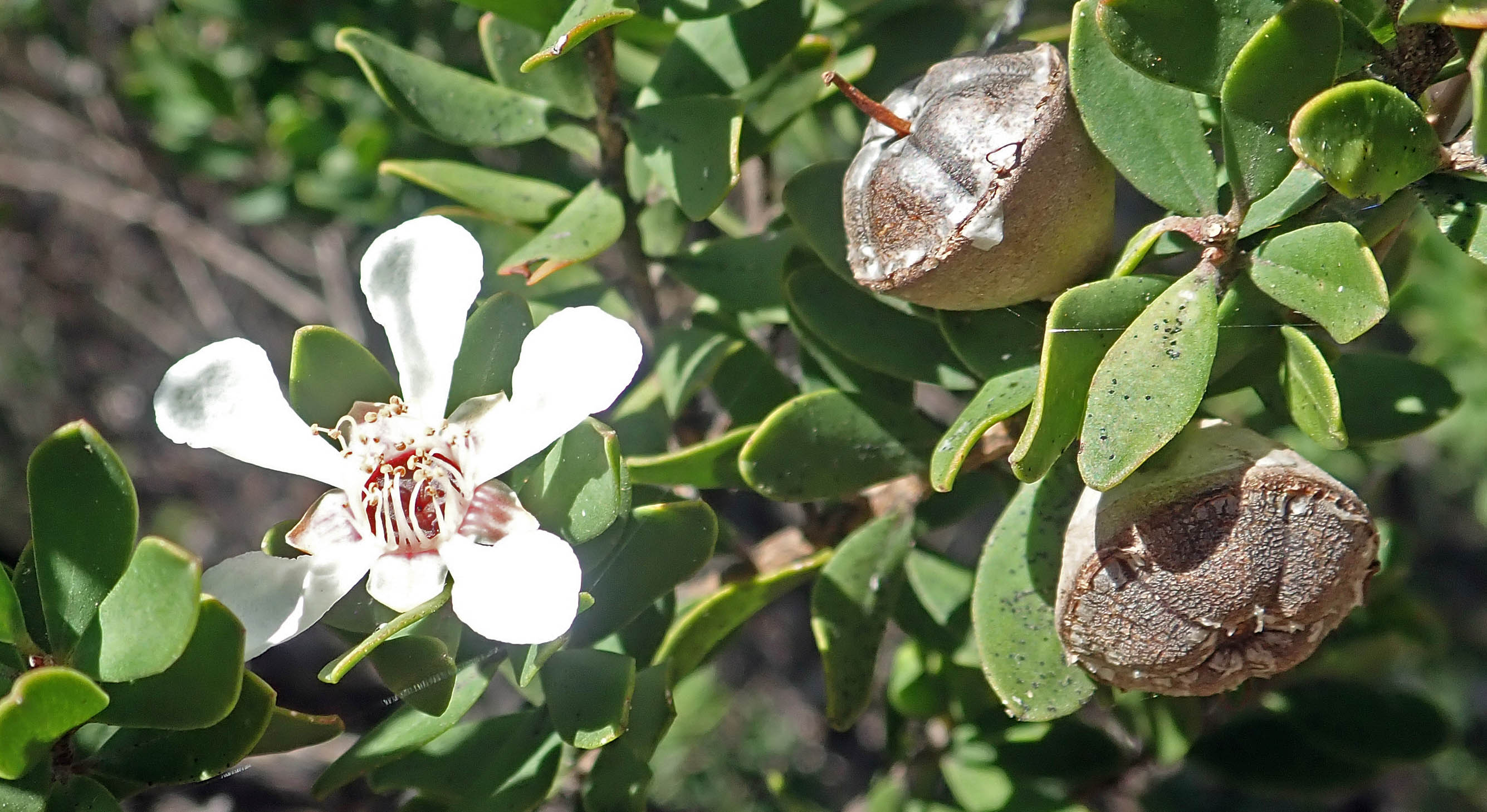 (Cape Hauy, Tasmania)
(Cape Hauy, Tasmania)There are also groups of trees that were once classified as Eucalypts, but were split from the huge genus, such as Angophora. Below is Angophora hispida, 'Dwarf Apple'. It has flakey bark, usually grows as a shorter mallee-like tree. It has distinct sessile (no stem) leaves, and is endemic to the open woodland (and heathlands) in the Sydney sandstone region.
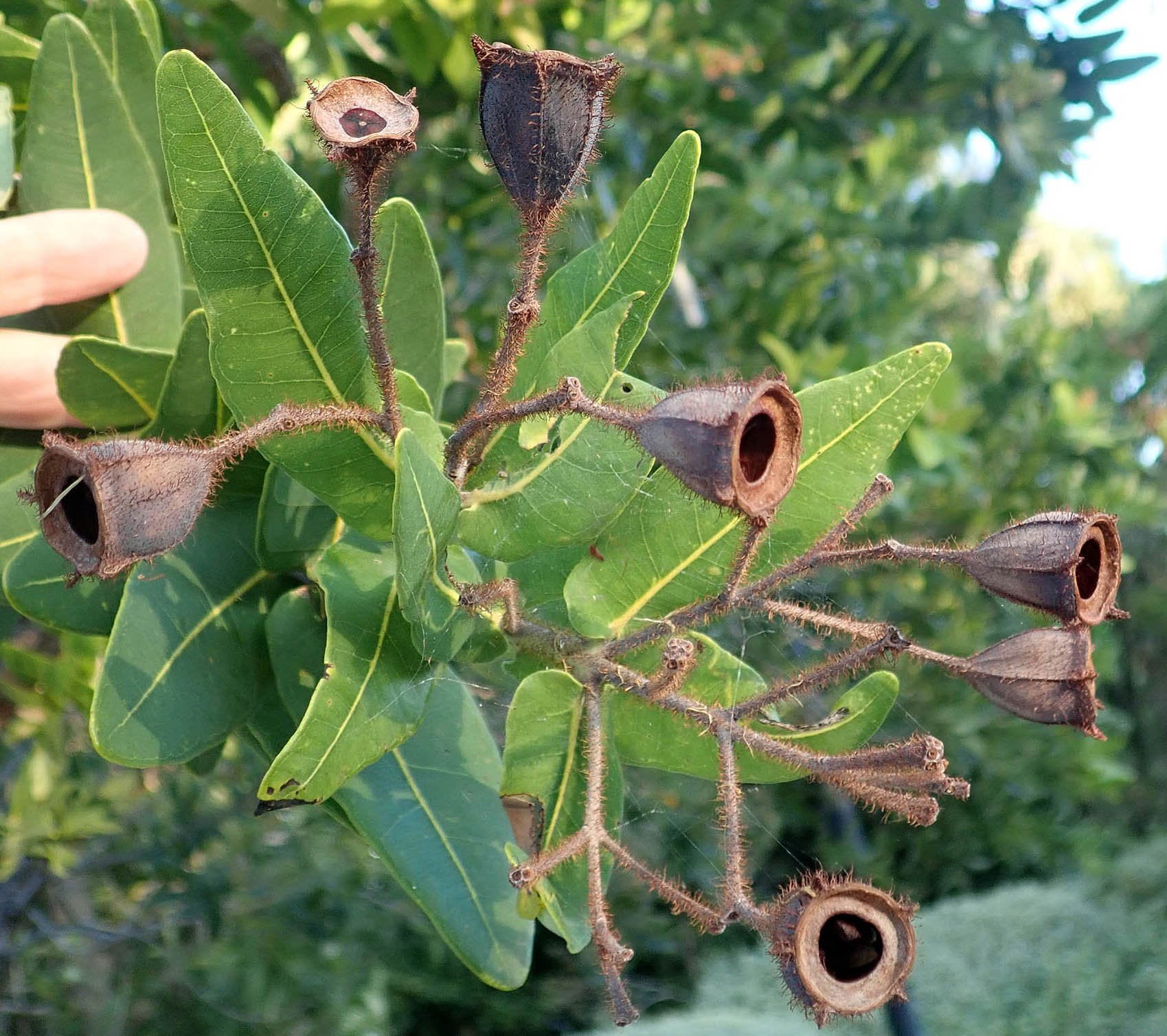
The infamous 'Bulldog Ants' of the genus Myrmecia are large ants with large mandibles and eyes. They are known for their painful bite, among the most dangerous of insects. All species (except one in New Caledonia) are endemic to Australia, particularly the temperate woodlands of south-east Australia. Below is the 'Inchman' Myrmecia forficata, the typical large amts of the genus, although not quite an inch in length. They have a purple-ish body, shiny black abdomen. They have a painful bite, considered the most toxic of all the Bulldog ants. Within south-eastern Australia, they are most common at higher elevations (the Australian Alps) on the mainland, and lower altitudes in Tasmania.
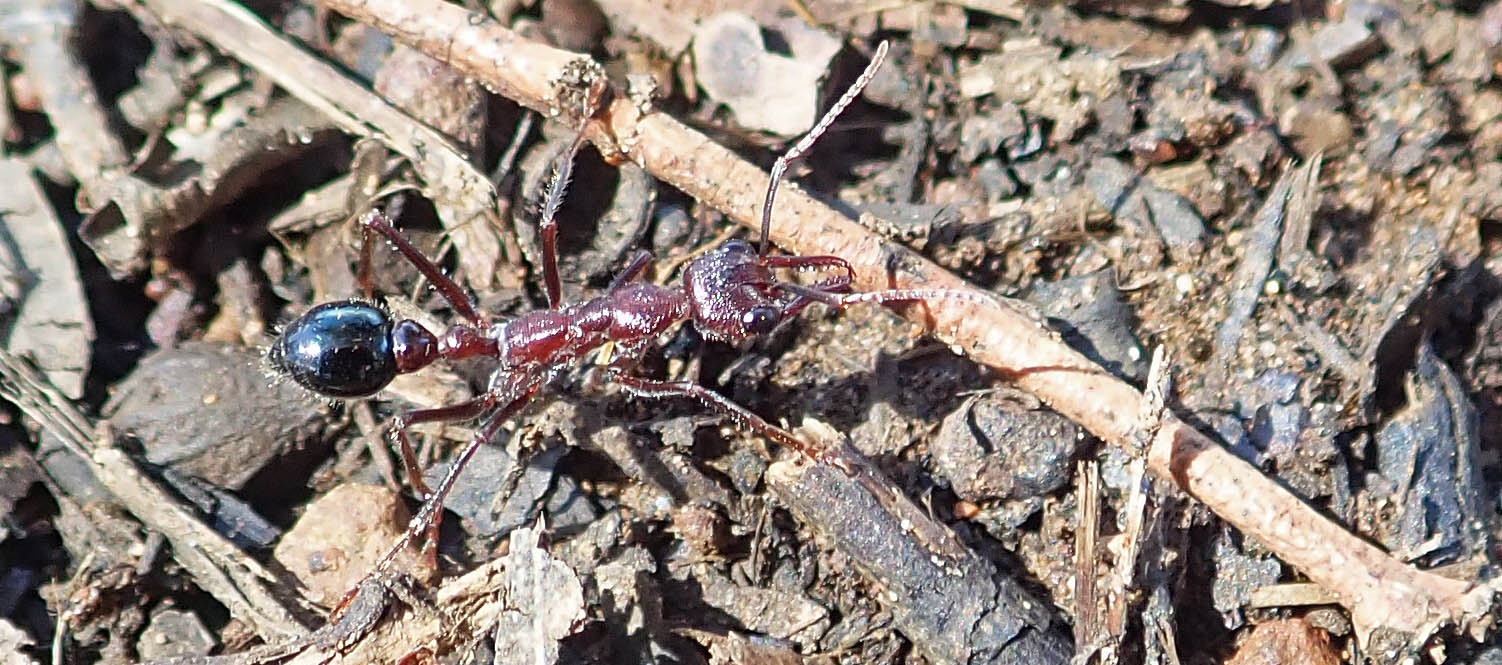 (Adventure Bay, Bruny Island, Tasmania)
(Adventure Bay, Bruny Island, Tasmania)Ranoidea caerulea, 'Australian Green Tree Frog', 'Dumpy Tree Frog', 'White's Tree Frog'. Probably the most commonly seen large tree frog in temperate Australian woodlands. Call is loud, rough and slow 'rawr.....rawr....rawr". Common in the pet trade. Found across Australia, sometimes even in toilet bowls.
 (Crow's Nest National Park, Queensland)
(Crow's Nest National Park, Queensland)Reptiles range from tiny skinks to large goannas. Skinks are by far the biggest family of reptiles in Australia, including in the temperate woodlands, and there are many regional endemics: below is Carinascincus ocellatus, 'Ocellated Cool Skink', 'Spotted Skink', which is endemic to Tasmania.
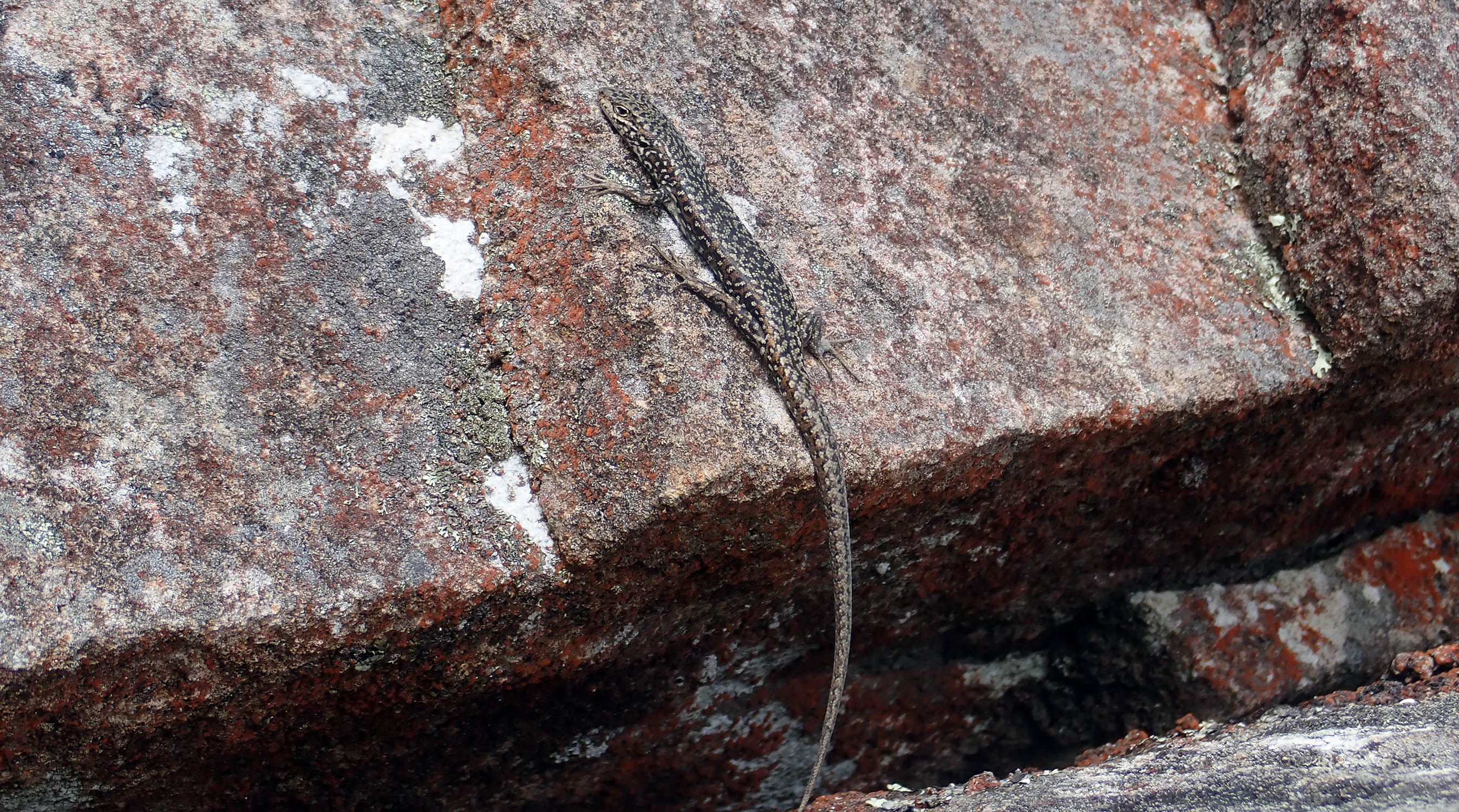 (Bishop & Clerk, Maria Island, Tasmania)
(Bishop & Clerk, Maria Island, Tasmania)Varanus varius, 'Lace Monitor'. The most commonly seen of the goannas. Found in various habitats, including around picnic areas, along entire length of east coast of Australia.
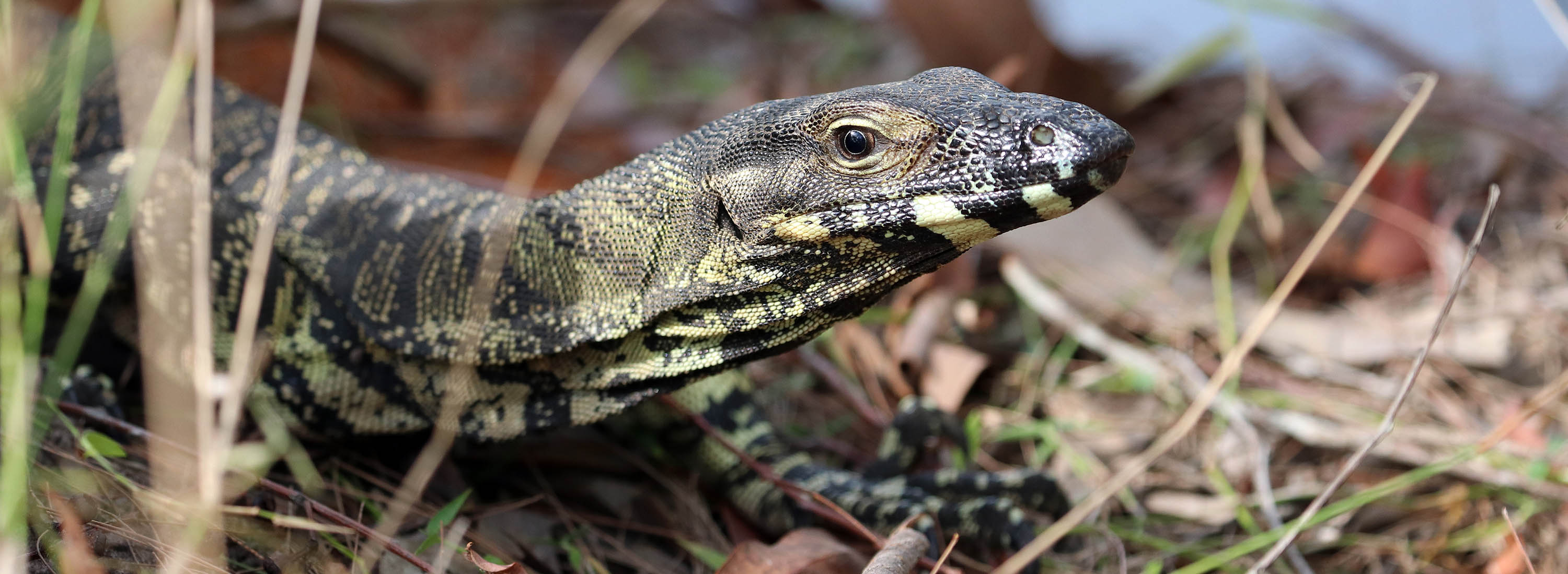 (Beerwah, Queensland)
(Beerwah, Queensland)One of the bird species that symbolises the Australian temperate Eucalyptus forest and woodlands (and Australia in general for overseas people) is the 'Laughing Kookaburra' Dacelo novaeguineae. Their small family groups re-affirm their tightly controlled territories by calling right at dawn and dusk; this is the famous 'laugh'.
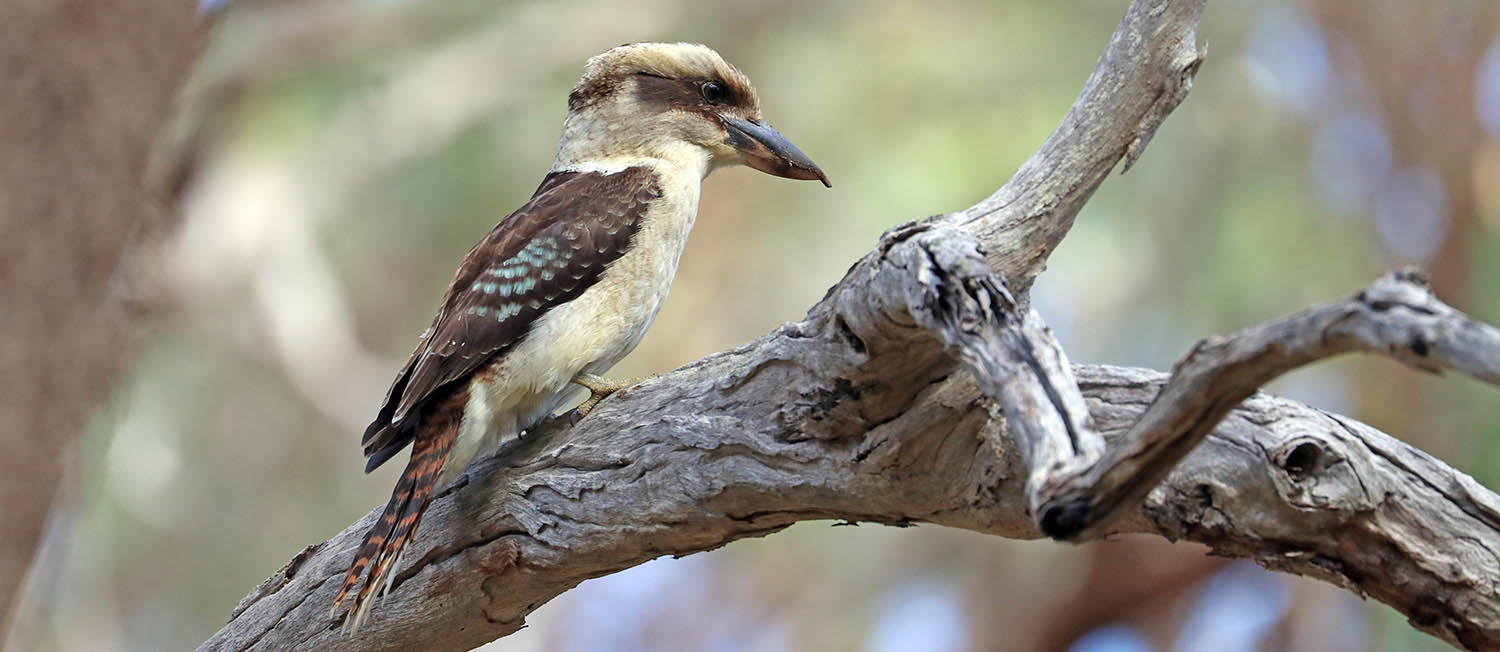
The most obvious and spectacular group of birds in the temperate forest and woodlands of Australia are the ‘Parrots’. They are mainly found in the southern continents and the tropical regions of the world. There are many different kinds of parrots, yet they comprise a distinctive group of birds that most anybody would recognize because of a suite of familiar characteristics. The skin around the eye is often obvious, enlarged and appears fleshy, the bill is usually well developed, with a large hooked, down-curved upper mandible, over a smaller up- curved lower mandible. The arrangement of the feet is also unusual, with two toes pointing forward, and two backwards. Most do not build nests, but raise their young in the existing hollows of trees, or excavate holes in banks, cliff faces, or termite mounds. Parrots are not territorial and quite sociable, and can thus occur in large flocks. Most parrots have basic screeching calls that are not thought of as particularly melodious. While there are more species in the Neotropical rainforests than anywhere else, it is in Australia where the group attains their greatest ecological, morphological and colour diversity, and they can be found from the deserts to the tropical rainforests. The parrots of Australia's temperate forests range include white, black, pink, blue, and even species with every colour of the rainbow!
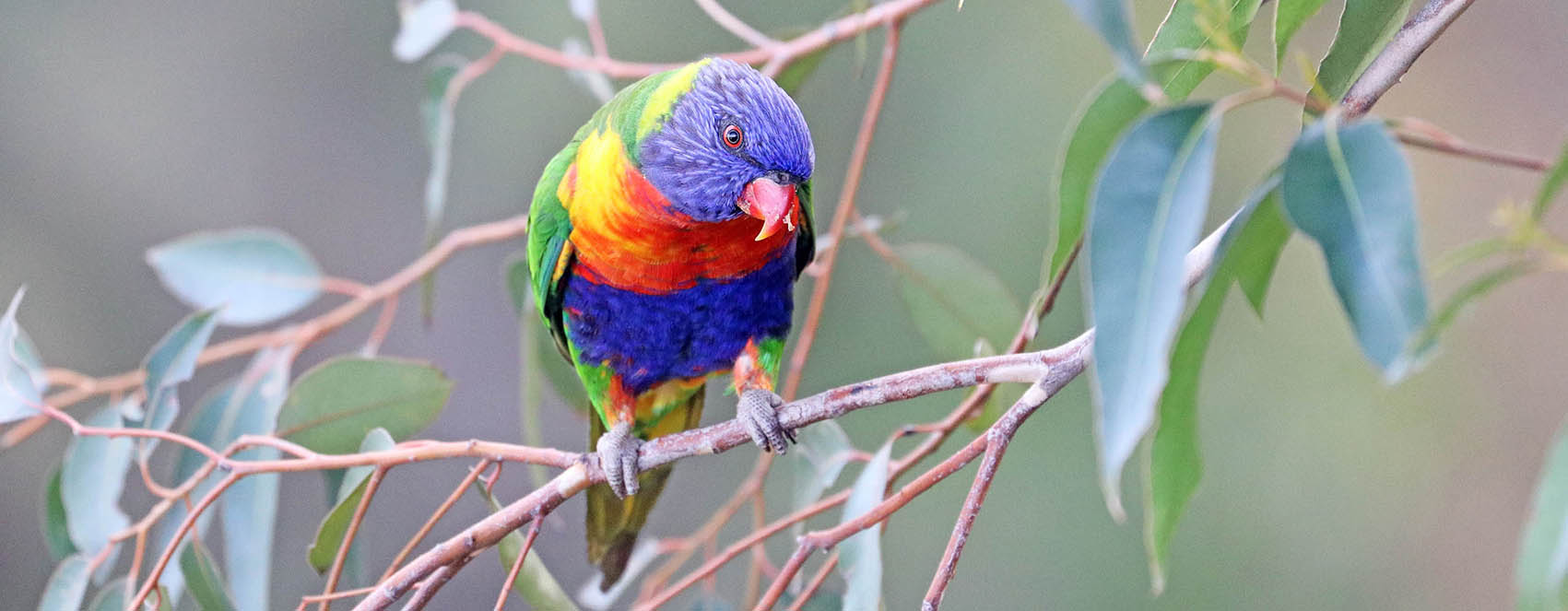
One of the more commonly seen species of parrot and one that is taken for granted by most Australians, is probably the most colourful of all, the 'Rainbow Lorikeet', Trichoglossus moluccanus. Lorikeets are parrots that slurp on nectar with brush-tipped tongues.
The parrots called 'Rosellas' were named for a suburb called Rose Hill where they were commonly seen; over time their name morphed from "Rose Hiller" to "Rosella". Platycercus adscitus, 'Pale-headed Rosella' is one of the less flashy species that is found in temperate and tropical open forest and woodlands in eastern Australia.
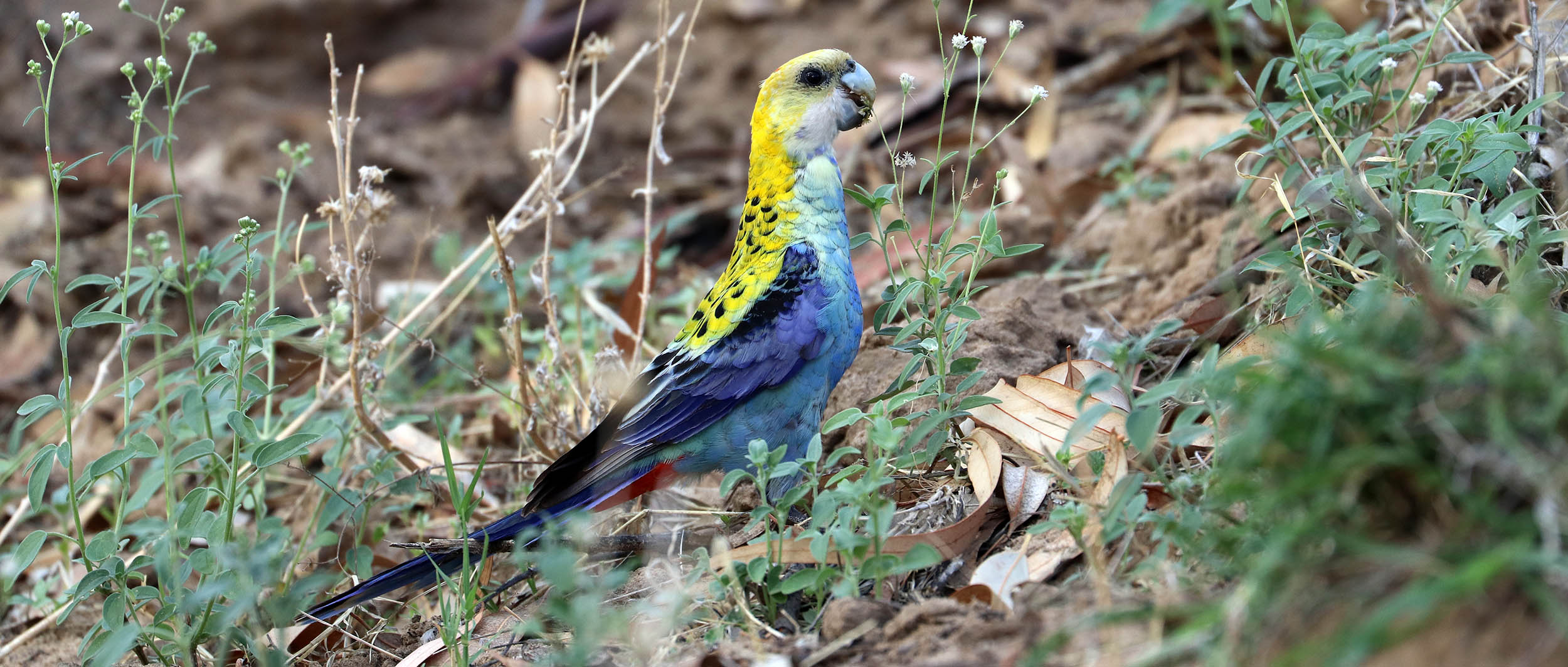
This family Cacatuidae includes about 21 species. They are mostly found in Australia and New Guinea, with a few species in Indonesia and one in the Philippines.
The family Pachycephalidae includes the Shrike-thrush & Whistlers, birds that the average Australian may not recognize, but they would recognize the calls as 'classic Australian bush calls'. One of the more classic and commonly heard calls in the Australian temperate forests and woodlands comes from the 'Grey Shrike-thrush'.
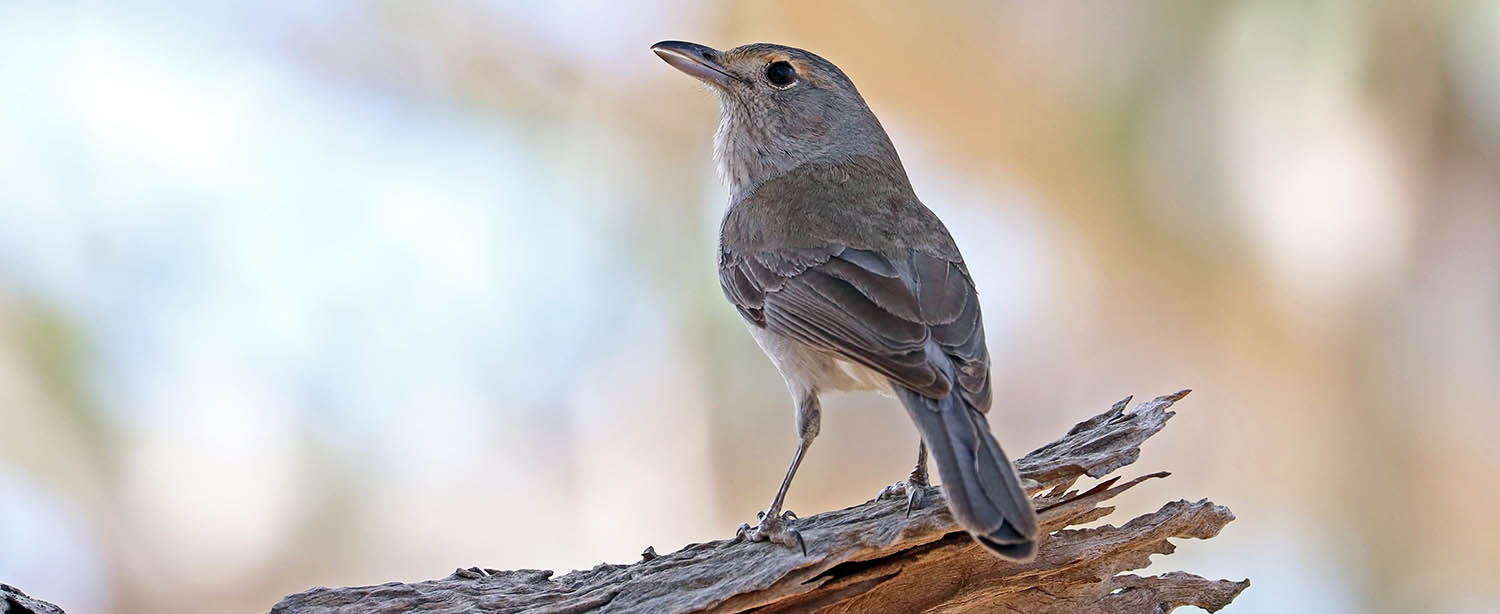
One of the larger and more common birds of the Australian bush, even in cleared areas, is the 'Australian Magpie', Gymnorhina tibicen.
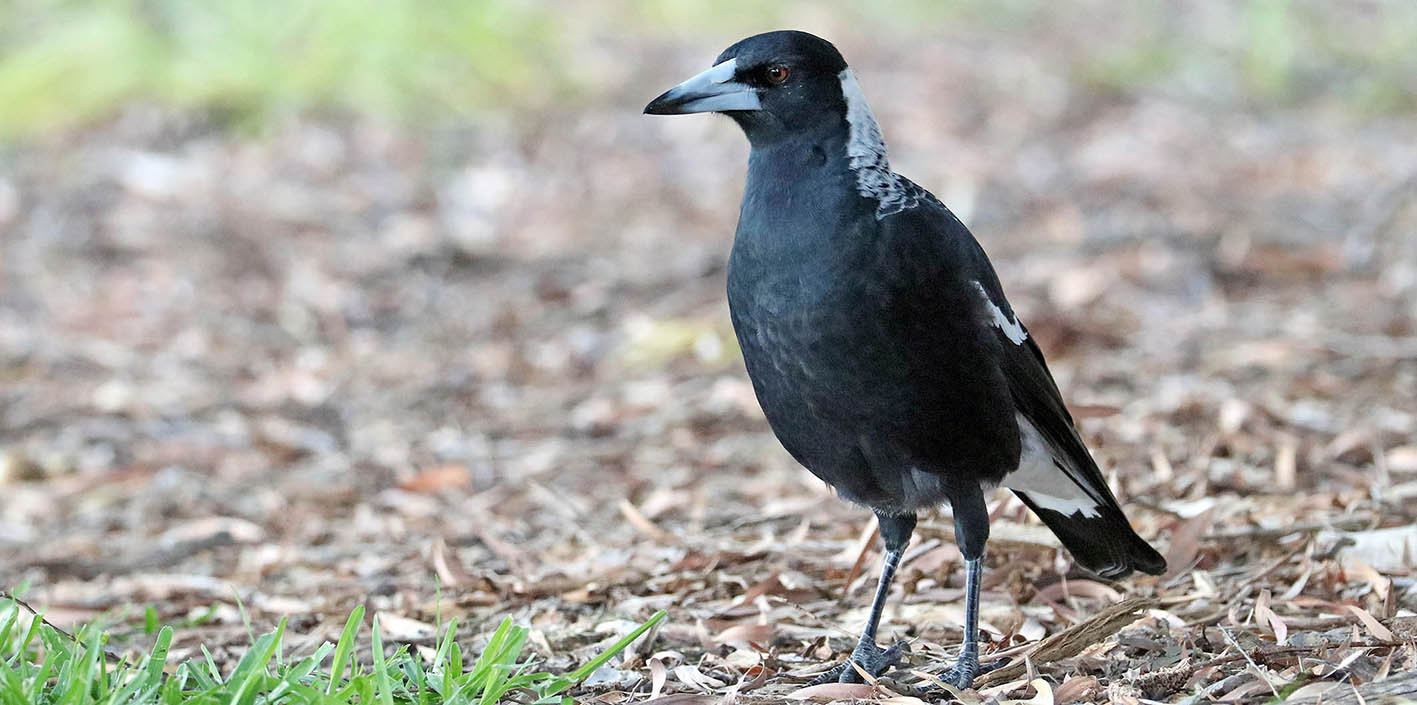
Some of the best known and prettiest small birds of the Eucalyptus forest are the 'Australian Fairy Wrens' of the family Maluridae, including Malurus cyaneus, the 'Superb Fairy Wren'.
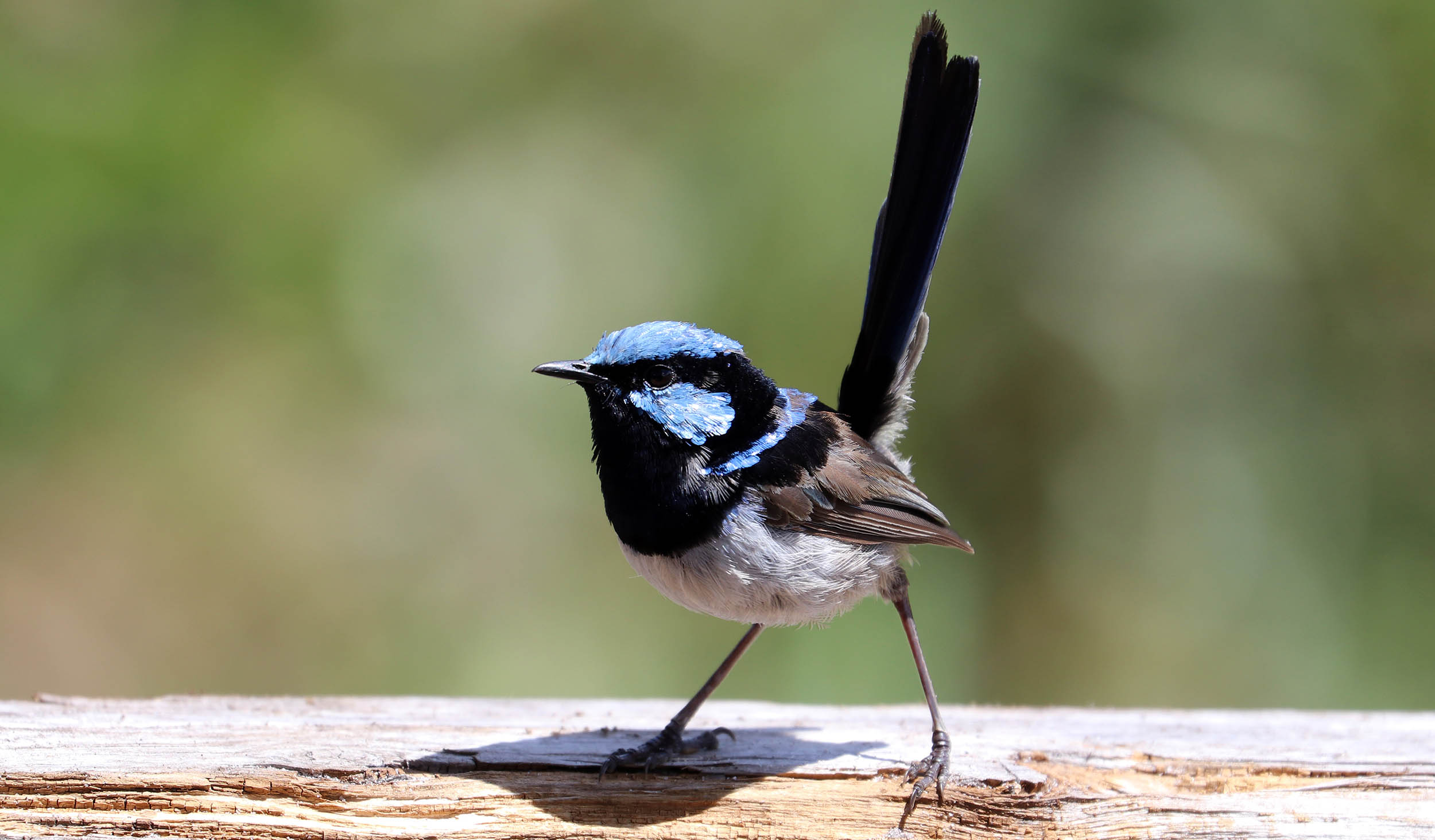
The large and relatively recently revised family Acanthizidae includes many different types of birds such as Australian Warblers, Thornbills, and Scrubwrens. These constitute many of the small and initially indistinct birds of the forest, also known colloquially as ‘little brown jobs’. However, a bit of patience and closer inspection reveals many of the species to be quite attractive. Below is Acanthiza pusilla (zietzi), 'Brown Warbler' (subspecies).
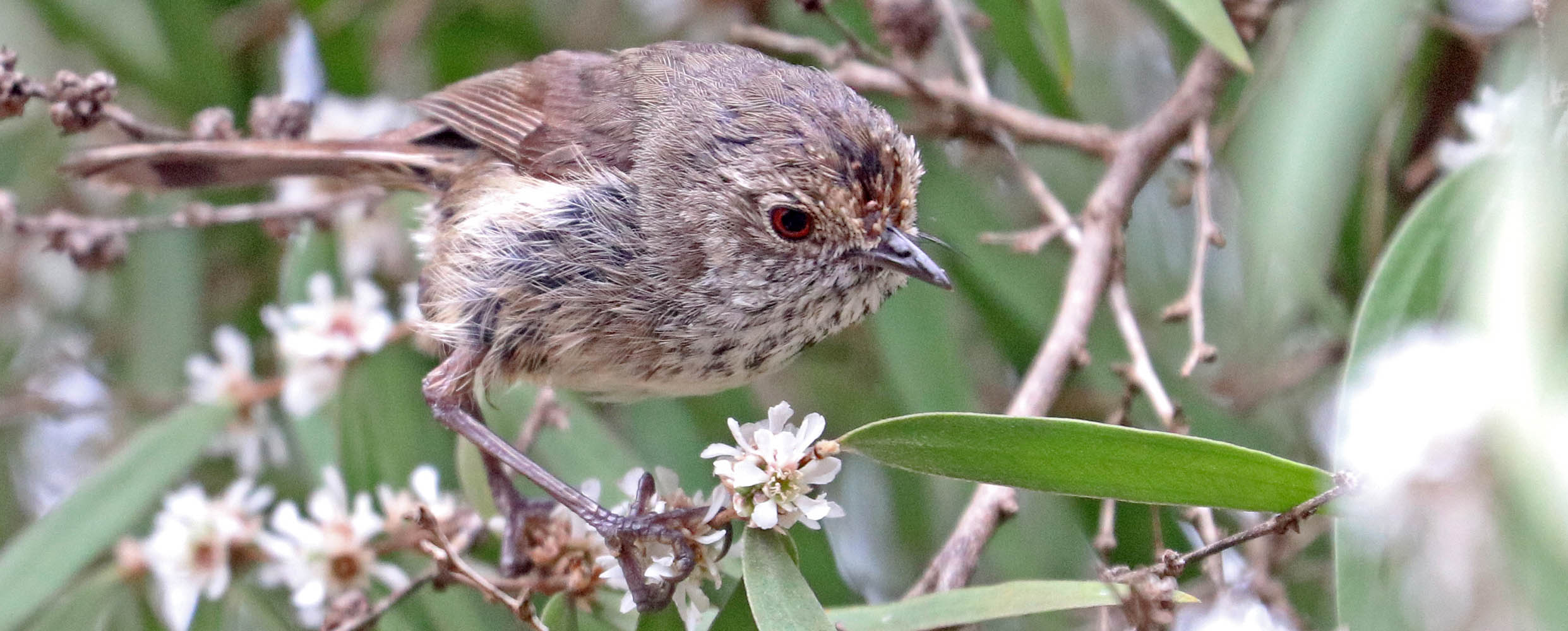
The largest family of birds in the temperate forests and woodlands of Australia, (as across most habitats across Australasia) are the Honeyeaters. One of the more commonly seen species is the 'New Holland Honeyeater'. It has striking contrasting colours, is energetic and fast, and is usually seen on large flowers, such as Banksias and Grevilleas. It is found in both south-eastern and south-western regions of Australia.
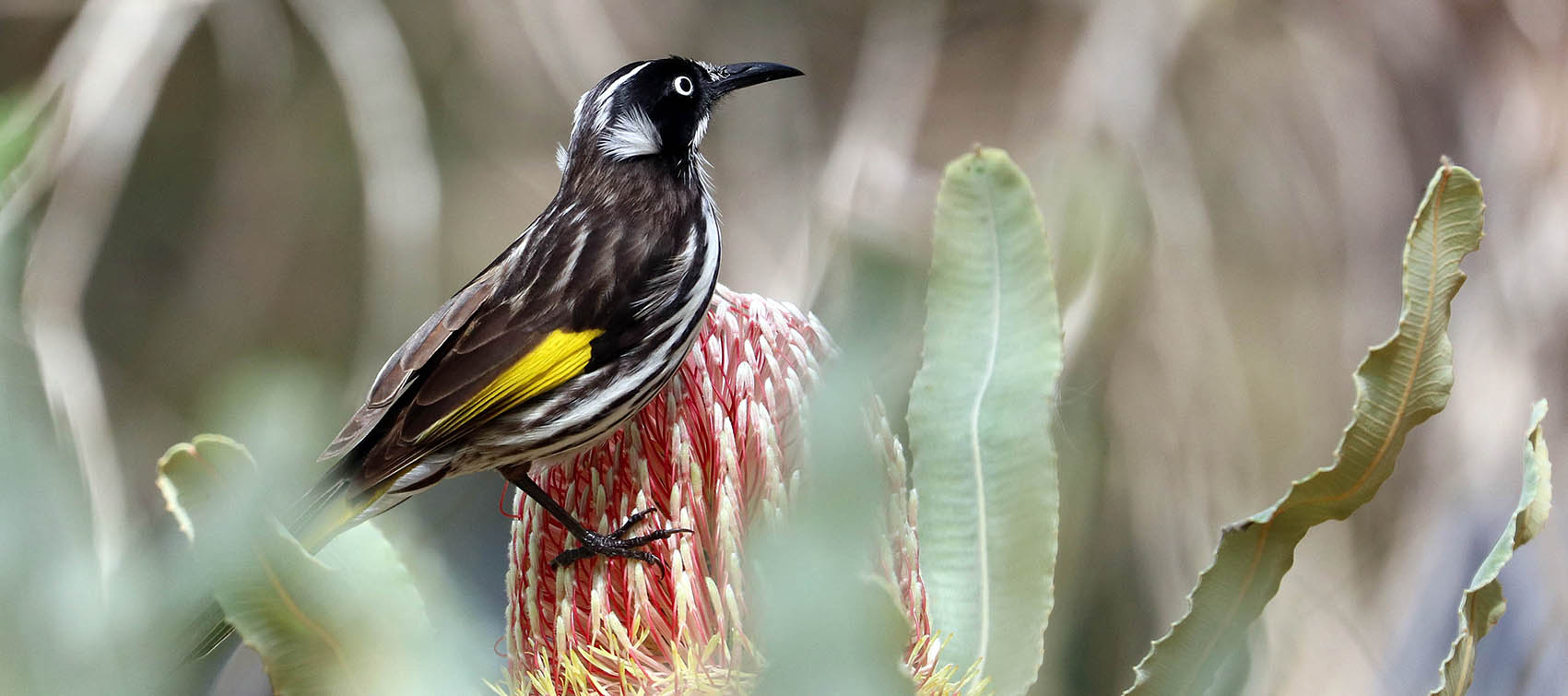
The most obvious, largest and most agrressive are the 'wattlebirds'. The 'Red Wattlebird' is distributed across south-eastern Australia, up to southern Queensland, and is the most commonly seen wattlebird of south-west Australia.
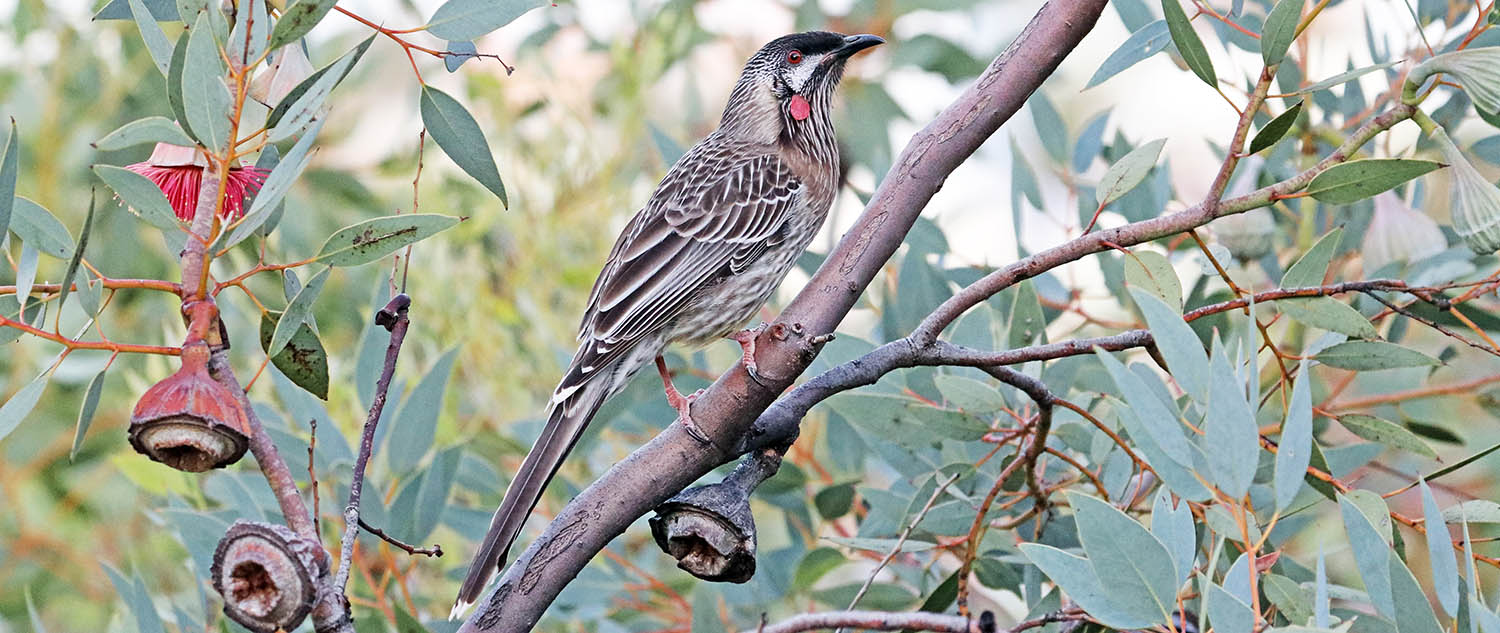
There are several bird species that migrate down the east coast in the southern summer from either Australia, New Guinea or Asia.
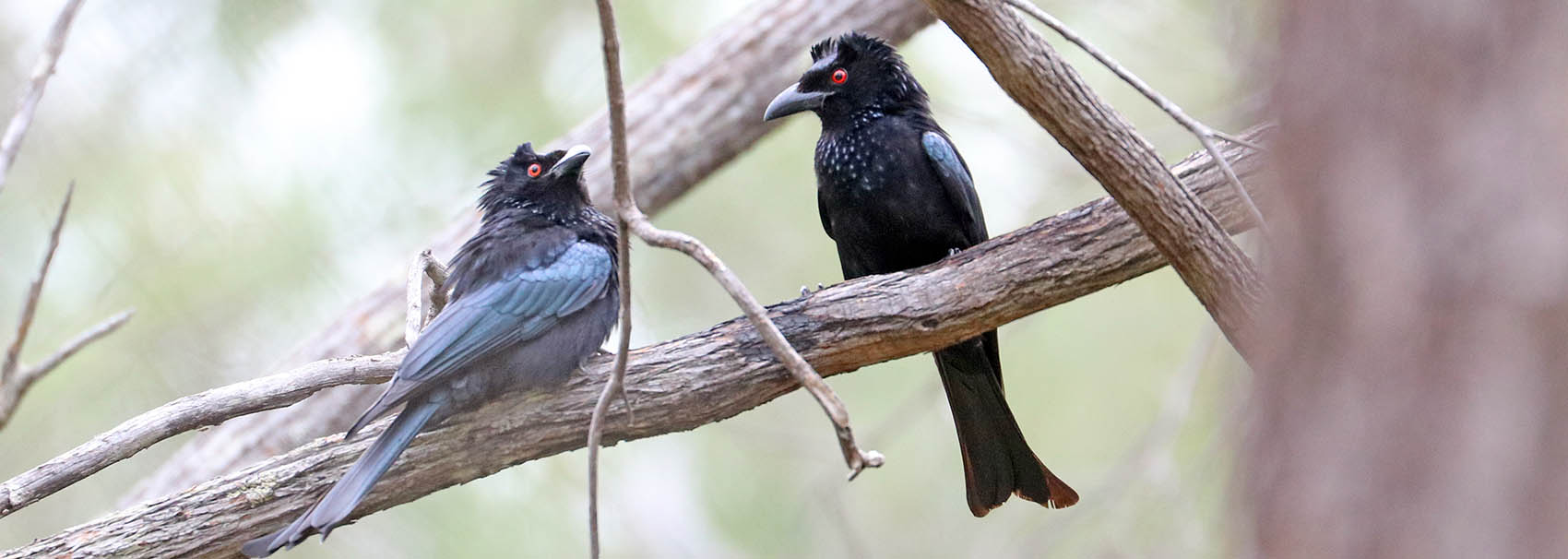 (Crow's Nest National Park, Queensland)
(Crow's Nest National Park, Queensland)The family Phascolarctidae contains the Koalas. Although there have been other species in prehistory. today there is only species in this family.
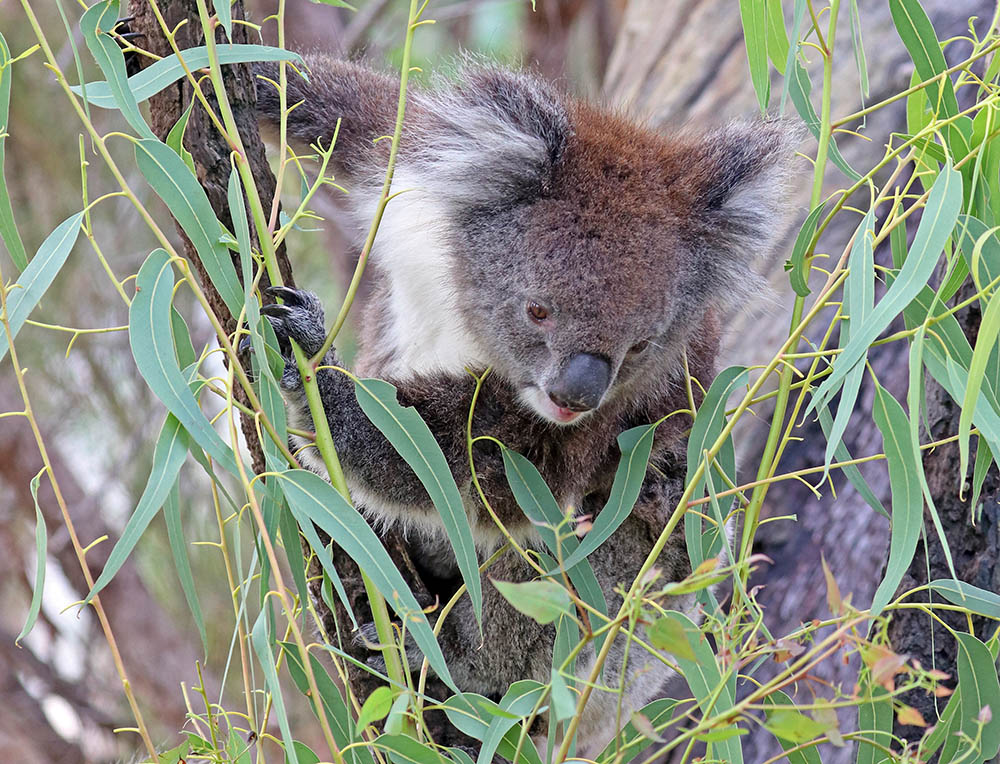
The Koala feeds mostly on the leaves of about 30 species of Eucalyptus trees. With such a low nutrient diet, Koalas spend a lot of their lives asleep; they are usually resting for 20 hours out of every day. Koalas two opposable digits on their 'hands', enabling grip on branches. Another adaptation to climbing and holding onto trees are their sharp claws! So even though they look calm and cuddly, don't try to pick one up, or they will scratch you with those claws!
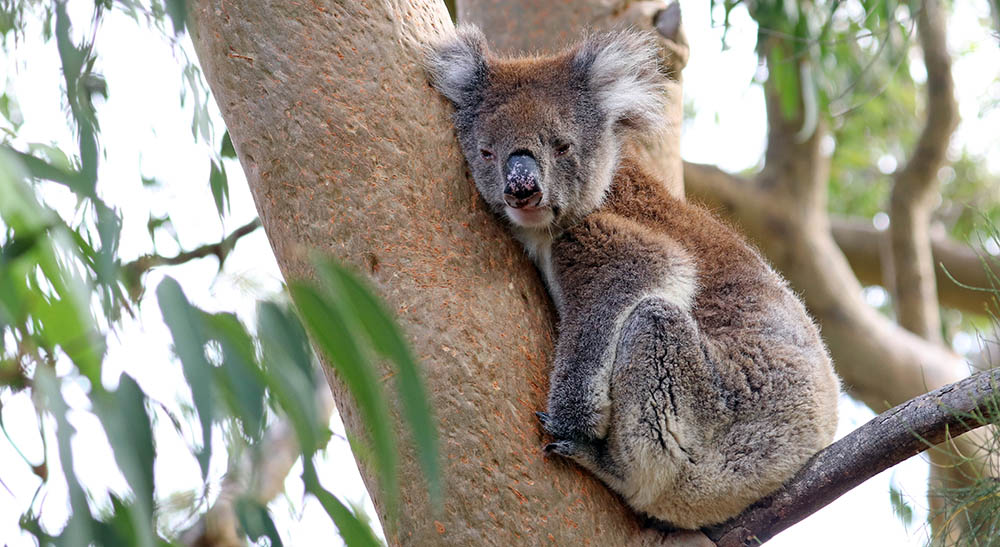
The family Vombatidae includes three species of living wombat. They are pretty cute: a big furry lump with short legs. Wombats are the largest burrowing animals in the world. They mostly feed by grazing on grass. They are literally "hard-asses", with a re-enforced layer of cartilage under their skin across their rear end. Speaking of the back end, they have one of the most interesting and distinctive of all Australian scats: their poo is cube-shaped, and often pooped out into an obvious place. And they produce a lot of it, up to 100 poops a night. All three species of Wombat are endemic to Australia. The species most associated with south-eastern forests and woodlands is also the most commonly seen: Vombatus ursinus, 'Common Wombat'.
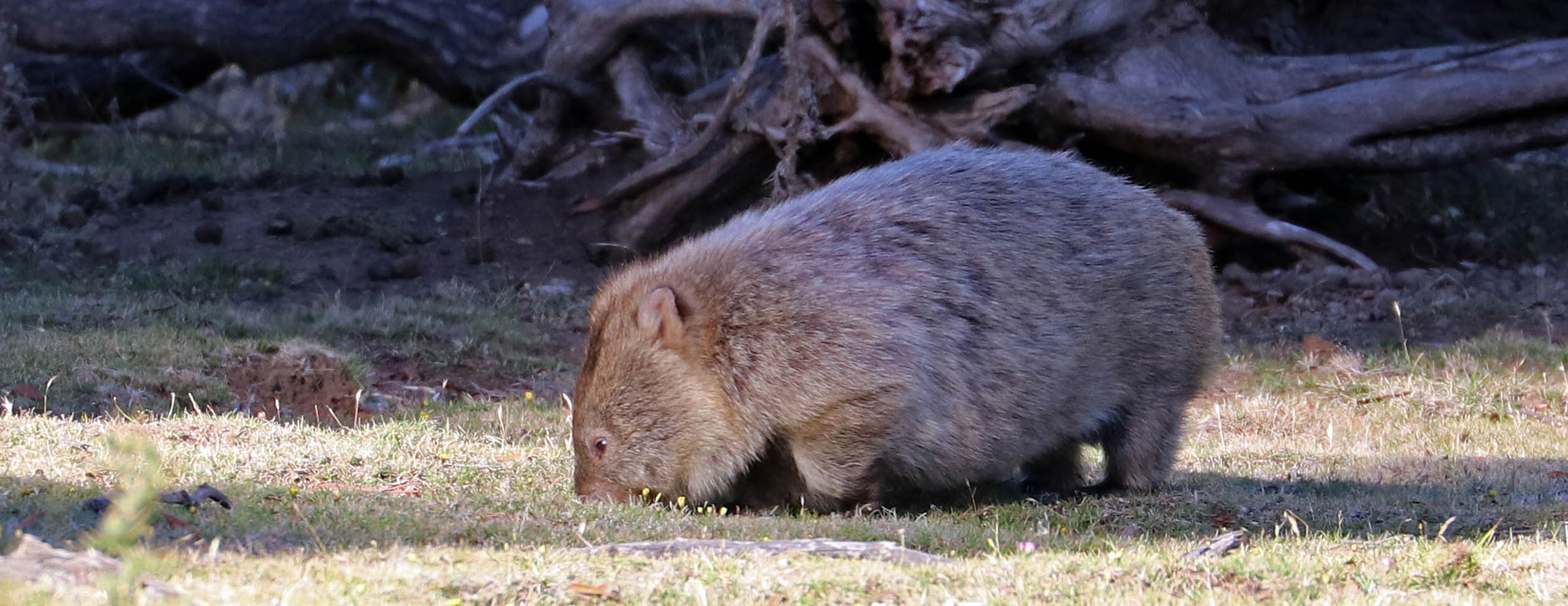 Common Wombat grazing (Maria island, Tasmania)
Common Wombat grazing (Maria island, Tasmania)The family Pseudocheiridae includes at least 15 species in a range of genera, mostly 'Ringtails'. They are found in New Guinea, Australia, and some surrounding islands, with 7 species in Australia. They may feed on fruits and flowers, especially around gardens, but generally the bulk of their diet is leaves. They are also usually quieter than many other possums; their less reliance on vocalization in communication is reflected in their smaller ears. As suggested by the name, Ringtails have a tail that is often held curled, and are usually not as fluffy as 'brushtails'. Below is the most common species in the south-eastern forests, woodlands (and gardens): Pseudocheirus peregrinus, the 'Common Ringtail Possum'.
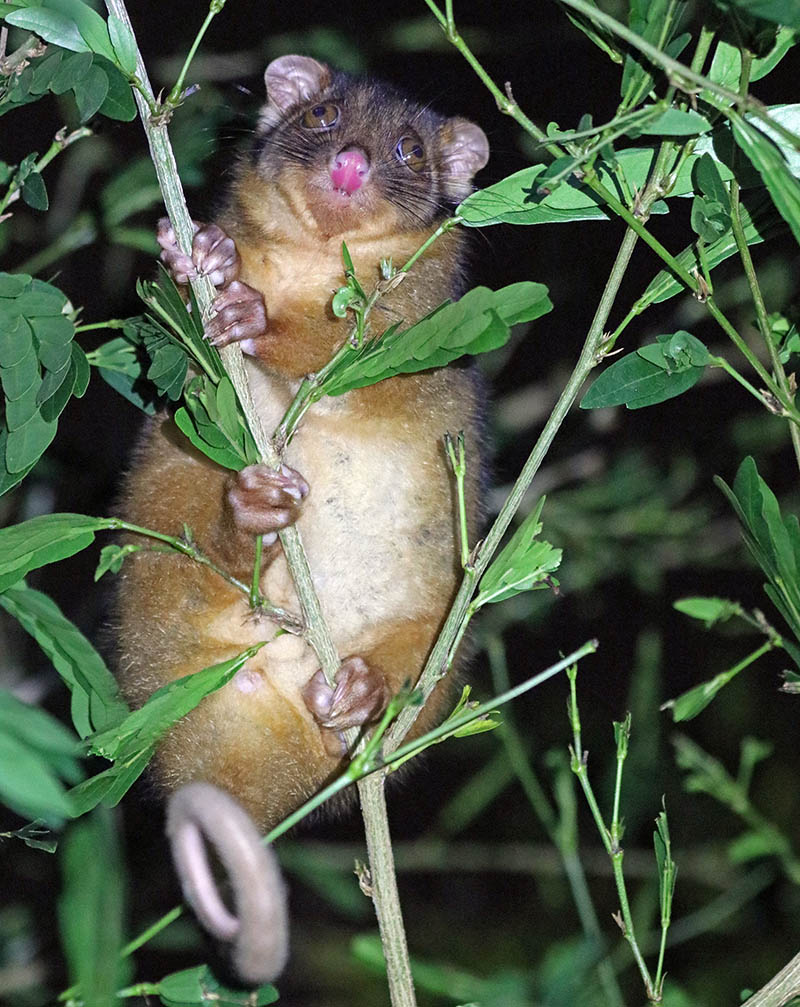 (Maroochydoore)
(Maroochydoore)The same family that contains the Ringtails also includes several species of possums that glide. Gliding in Australasian possums has evolved separately twice in two different families. Below is the 'Greater Glider' Petauroides volans. This species has now been split into 3 species. It is a larger fluffier possum than than the species in the 'glider family'. It often stays still in same tree for some time. They are found in Eucalyptus forest and woodlands all along the eastern seaboard of Australia.
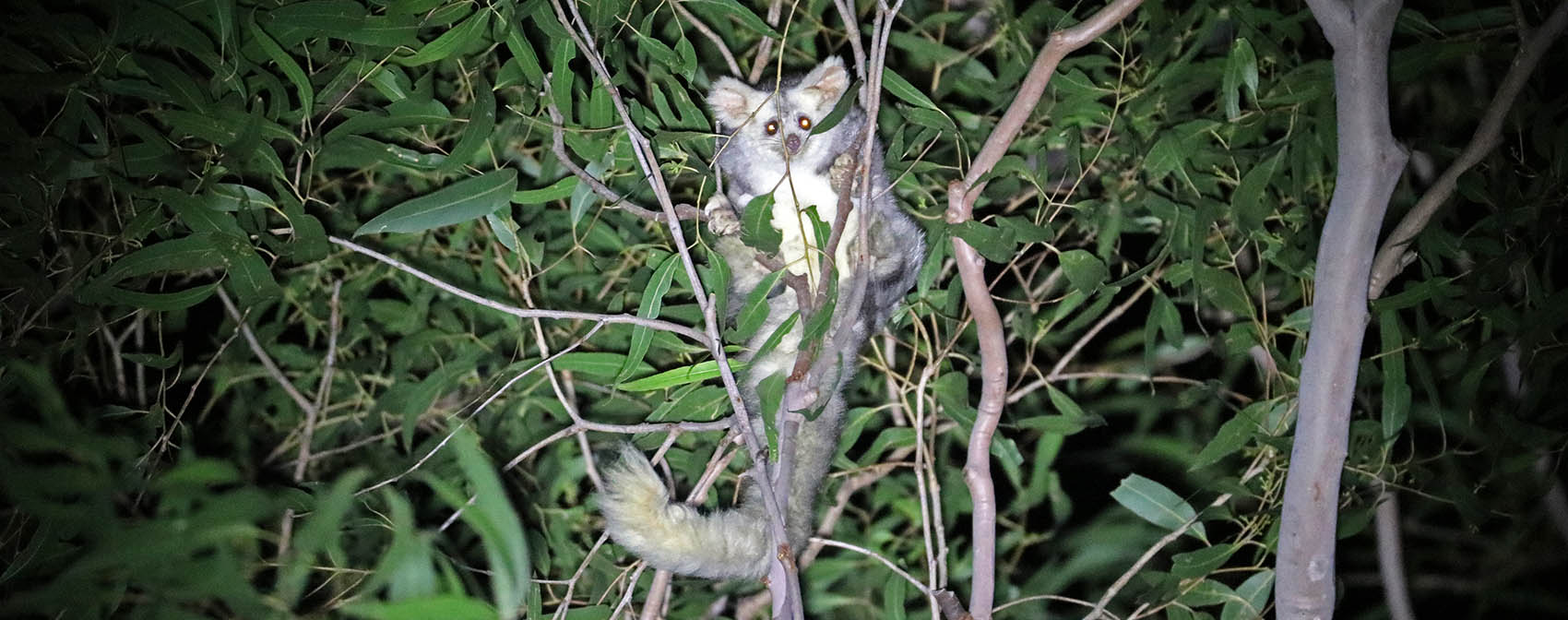 (Borania Calrossie Forest reserve, Queensland)
(Borania Calrossie Forest reserve, Queensland)The 'true gliders' of the family Petauridae are usually grey or brown in colour, with a bushy tail and a darkish stripe on the back that often extends to the forehead. They are referred to as the ‘wrist–winged gliders’, as most have a loose flap of skin between the wrist and ankle on the same side. This appears as a loose fold of skin when climbing, but when jumping from tree to tree the skin is stretched and acts as a gliding surface. They have been reported to glide up to 100 meters. Gliders use their sharp lower incisors to chew into trees and then lick the resulting sap and gum. This is especially so in winter, when their other foods such as insects and other invertebrates are rare. Below is Petaurus norfolcensis, 'Squirrel Glider'. It is similar looking to the more commonly seen and widespread Sugar Glider, but this species is larger, with larger ears and much bigger fluffy tail.
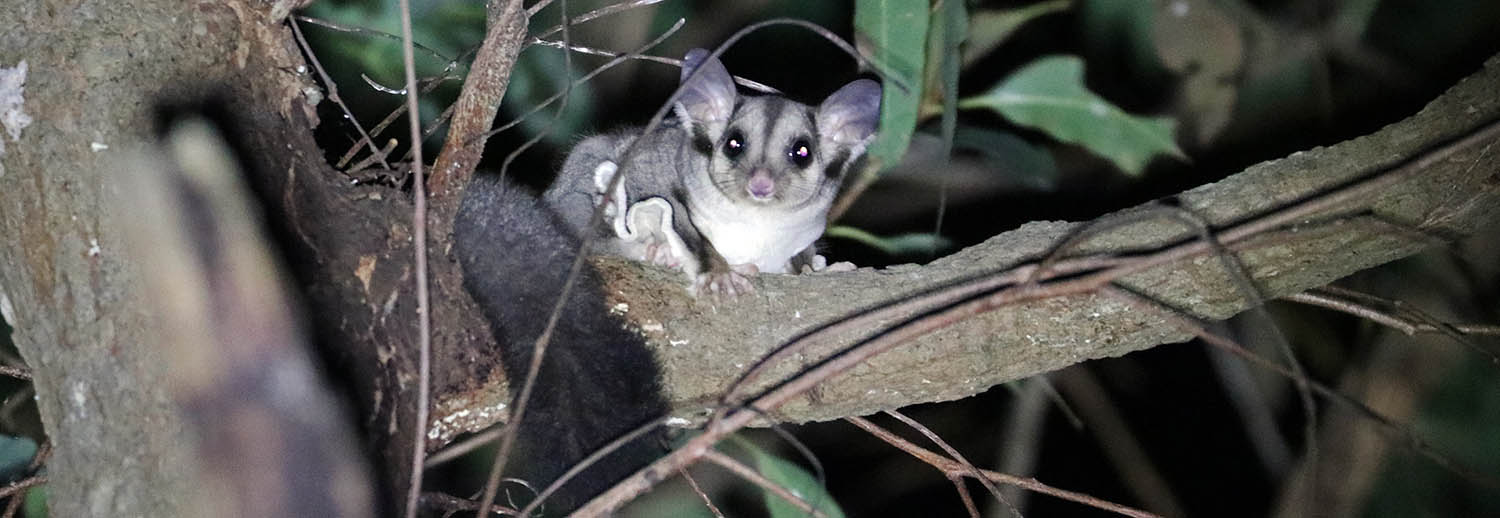 (Coochin Creek, Beerwah, Queensland)
(Coochin Creek, Beerwah, Queensland)The genus Macropus includes many of the larger and best known kangaroo species. Kangaroos are the largest animals in the world to using hopping as locomotion, or indeed that have ever lived. The most commonly seen species on the temperate east coast is Macropus giganteus, 'Eastern Grey Kangaroo'.
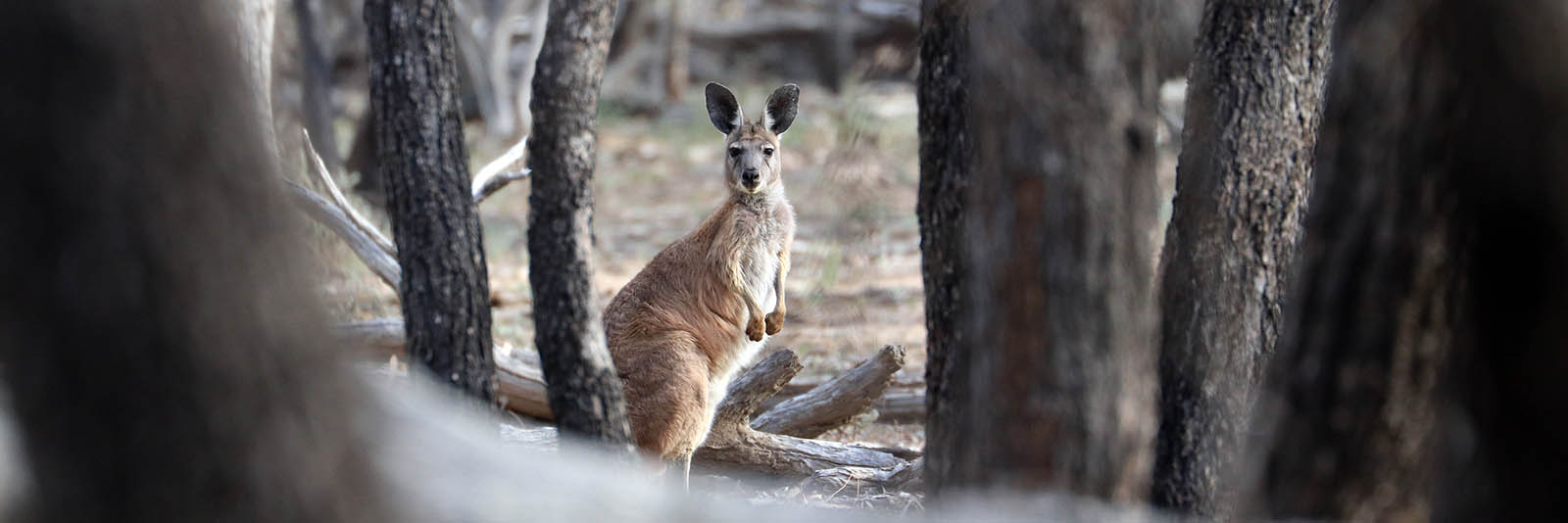 (Grey Lloyd Jones Weir, Queensland)
(Grey Lloyd Jones Weir, Queensland)A smaller species is Macropus rufogriseus, 'Bennet's Wallaby' or 'Red-necked Wallaby', found from southern Queensland to Tasmania. Pictured below is the Tasmanian subspecies of the Red-necked Wallaby'.
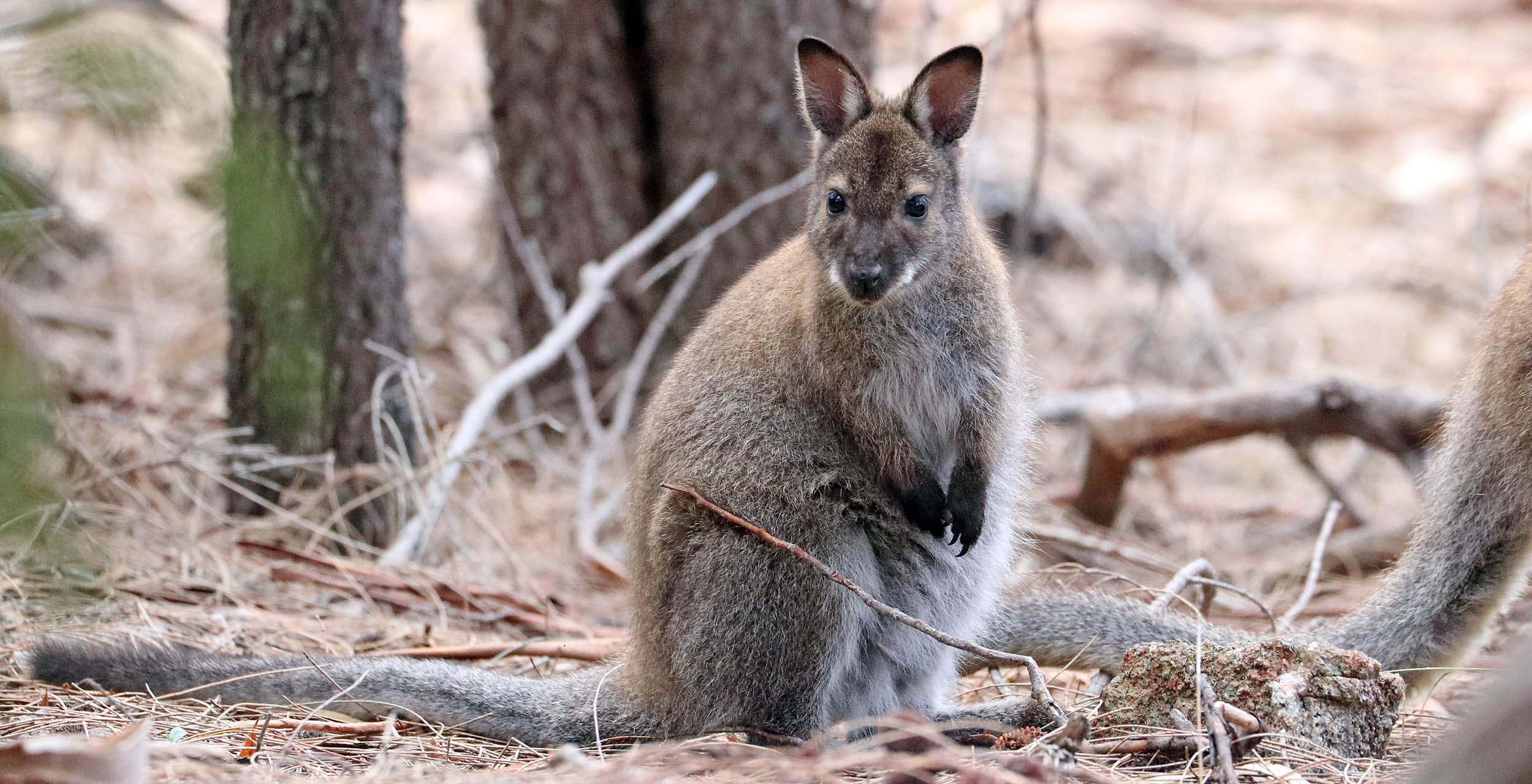 (Wineglass Bay, Tasmania)
(Wineglass Bay, Tasmania)The family Potoroidae contains the smaller hopping marsupials. Many are increasingly rare species. Below is Aepyprymnus rufescens, 'Rufous Bettong' 'Rufous Rat Kangaroo'. The largest of all the potoroids, but still a small marsupial. Often stands with kangaroo-like stance, but with tiny arms. Usually solitary, but sometimes in loose groups. Found in drier Eucalypt woodlands eastern Australia, from North Queensland south to northern NSW (it was once found down to Murray River).
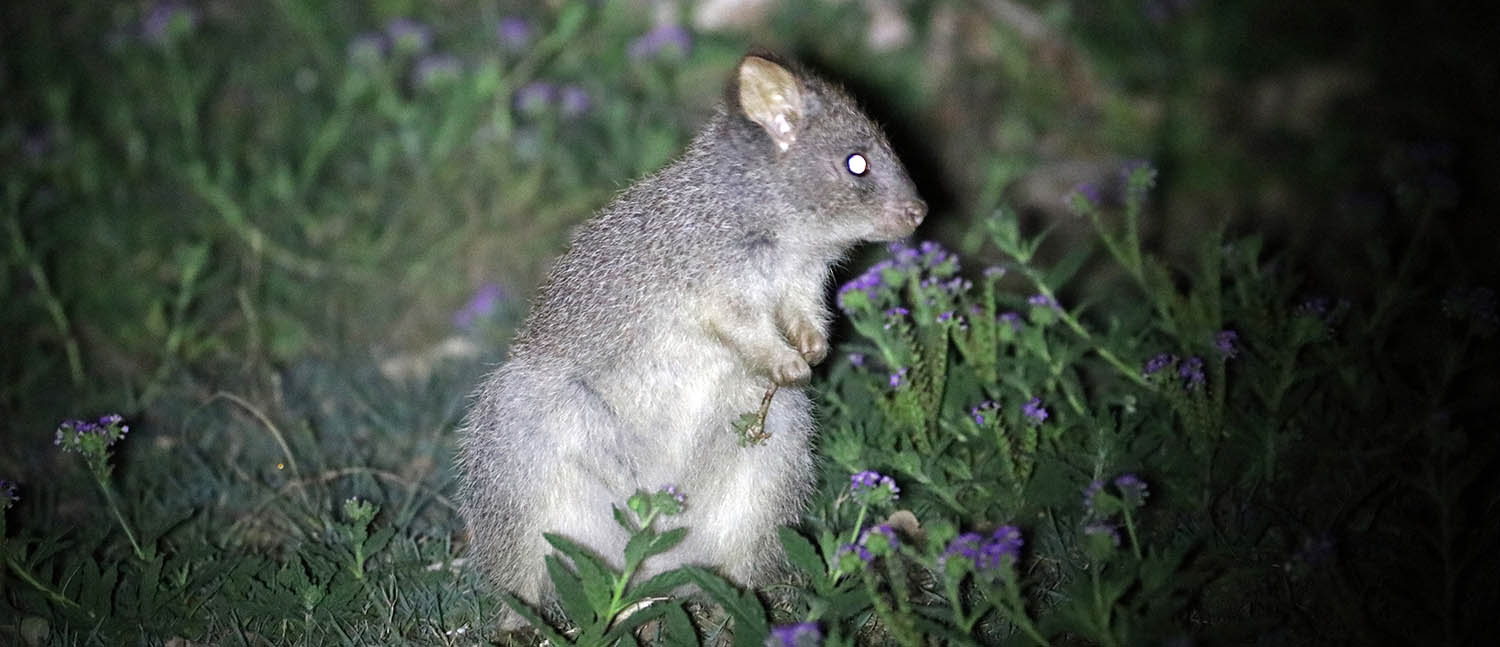 (Crow's Nest National Park, Queensland)
(Crow's Nest National Park, Queensland)The genus Petrogale includes all of the 'Rock Wallabies'. These are mostly found in tropical and arid areas. Below is Petrogale penicillata, 'Brush-tailed Rock Wallaby'. An increasingly rare rock wallaby of south-east Australia.
 (Brush-tailed Rock Wallaby, on Dam wall near Crows Nest National Park, Queensland)
(Brush-tailed Rock Wallaby, on Dam wall near Crows Nest National Park, Queensland)Of course there are also many placental mammals, not just marsupials, in the temperate forests and woodlands of Australia. The most commonly seen species is in the bat order Chiroptera. The family Pteropodidae contains the Flying Fox, with the main south-eastern species being the 'Grey-headed Flying Fox', Pteropus poliocephalus.
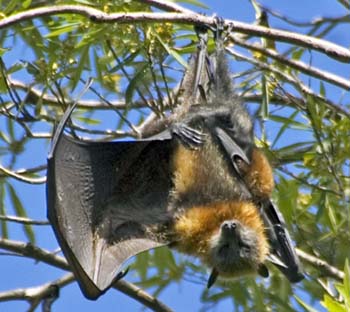 (Sydney Botanical Gardens, Australia)
(Sydney Botanical Gardens, Australia)


